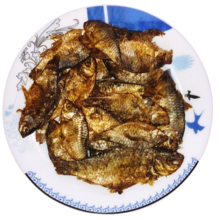Ngari (fish)

Ngari is a fermented fish product indigenous to the people of Manipur. Nga means fish in Meitei language and ri (riba/liba) means the process of fermentation.[1] It is used as a condiment in Manipuri dishes like eromba, singju, kangshoi, morok metpa, and others.
Ngari is also consumed in other southwest States of India.
Preparation and nutritional value
[edit]Ngari is made from small sun-dried pool barbs (Puntius sophore) locally known as phouba nga, which are 5-10 cm long. Traditionally, the fish is packed tightly in an earthen pot called ngari chaphou or kharung with a small amount of vegetable oil. The pot is then sealed with a fish paste, leaves, and mud and kept for fermentation at room temperature for about six months. Each of these pots can hold up to 15-75 kg of fish.[2]
It has a high source of protein, vitamins, and essential amino acids and fatty acids. It also aids in digestion and has pharmacological benefits.[3][4][5]
Production
[edit]There are families in Manipur who have been in the business of making ngari for generations.[6]
Nowadays, there are multiple commercial units in the business of ngari production in Manipur. The government licenses these units and they need to comply with the rules of the Food Safety and Standard Act, 2006.[7]
Concerns
[edit]A 2015 study reported that the population of phabou nga has been rapidly declining due to rising commercial activity around the production of ngari, and increasing pollution in and around the Loktak Lake. Adulteration in the production process by adding chemicals such as urea to speed up the fermentation has been reported.[8]
In popular culture
[edit]Olympic medallist Mary Kom said that ngari was one of the fermented fish varieties her family frequently eats.[9]
See also
[edit]References
[edit]- ^ "Taste of Manipur Ngari Fermented Fish". e-pao.net. 19 April 2023. Retrieved 2023-09-18.
- ^ "Food Fermentation In Northeast India". Northeast Today. 2020-04-27. Retrieved 2023-09-18.
- ^ Asem Sanjit Singh; Atom Arun Singh; Manoharmayum Shaya Devi (2012). "Ngari - a traditional fish product of Manipur, India". INFOFISH International: 41–45.
- ^ "Ngari: an indigenous fermented fish product from Manipur". e-pao.net. 18 January 2010. Retrieved 2023-09-18.
- ^ Narzary, Y.; Das, S.; Goyal, A. K.; Lam, S. S.; Sarma, H.; Sharma, D. (2021). "Fermented fish products in South and Southeast Asian cuisine: indigenous technology processes, nutrient composition, and cultural significance". Journal of Ethnic Foods. 8 (1): 33. doi:10.1186/s42779-021-00109-0. PMC 8579182.
- ^ Ghosh, Dakshina. "Fishing for flavour". Deccan Herald. Retrieved 2023-09-18.
- ^ "Ngari manufacturing units need to comply with food safety rules". The Sangai Express. 1 October 2013. Retrieved 2023-09-18 – via e-pao.net.
- ^ "Declining Population Of Phabou Nga (Puntius Sophore), A Staple Dietary Fish In Manipur: Ensuing Concerns" (PDF). DU Journal of Undergraduate Research and Innovation. Retrieved September 18, 2023.
- ^ Menon, Sudha. "Food and Family: Mary Kom's Walk Down Memory Lane". Reader's Digest. Retrieved 2023-09-18.
